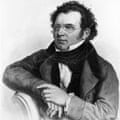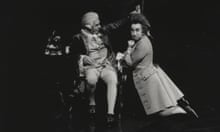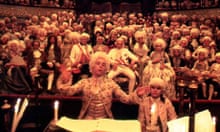I lazily plumped for Vienna as the latest stopping-off point on our tour of musical cities, thinking the sheer multiplicity of classical composers who have lived and worked there would make it easy. In fact, of course, it makes choosing which music to focus on very difficult. As the centre of Europe’s musical life for more two centuries, thanks to its status of capital of the Habsburg empire, many of the greats – notably Haydn, Mozart and Beethoven – gravitated to Vienna, and Schubert was born in the city.
The trusty @abkquan suggests choosing “pieces that describe the city and evoke its atmosphere rather than great pieces written by Viennese composers”. He offers the nature-loving Beethoven’s Pastoral Symphony, a work we take for granted but which, if you listen to it afresh, is little short of miraculous.
@abkquan is taken with the Viennese pastoral theme – the city does have it bucolic side – and also suggests Johann Strauss II’s Tales from the Vienna Woods and, inevitably, the Blue Danube, available in all manner of versions by everyone from the Vienna Philharmonic to André Rieu. The latter has no fewer than 16m hits on YouTube for his version. The Vienna Phil tend to get rather less.
We must have Johann Sr’s Radetzky March, written in 1848 when the Habsburgs were still managing to win battles. I was very pleased to stumble on a clip of the elderly Herbert von Karajan conducting the Vienna Phil at the New Year’s Day concert in 1987, Karajan smiling in a somewhat forced way and the audience largely terrified to clap along as they like to do with this traditional encore.
This entire column could be filled with the Strauss family. @abkquan draws our attention to Johann I’s second son, Josef, who died in his early 40s and was eclipsed by the success of his elder brother Johann. But the engaging Dorfschwalben aus Österreich (Village Swallows from Austria) demonstrates that he had the family’s facility with dance music.
But perhaps that is enough of the Strausses. Several commenters, including @thesecretorganist, suggest Ravel’s La Valse as an antidote to the chocolate-box view of Vienna. La Valse began life as a piece called Vienne, which Ravel saw as a tribute to the age of the waltz. After the first world war, he reworked it as a ballet for Diaghilev. The latter rejected it, leading to a rupture between the two, but it was quickly accepted in the concert hall.
Critics have always seen the work as a commentary on the disintegration of the Hapsburg empire after the war, but Ravel flatly denied that interpretation. “It doesn’t have anything to do with the present situation in Vienna, and it also doesn’t have any symbolic meaning in that regard,” he said in 1922. “In the course of La Valse, I did not envision a dance of death or a struggle between life and death.” It may, however, be one of those instances where the artist’s intention and the reality of the piece he writes diverge. Somehow, as the piece whirls to its climax, the listener can hear both the apotheosis of the waltz and its destruction.

We are on safer ground with Schubert, the Viennese composer par excellence. @thesecretorganist sums up his genius far better than I could: “He led perhaps the most agonisingly tragic life of any of the so-called great composers. Dead at just 31; seriously ill with what’s believed to be syphilis throughout most of his 20s; hopelessly in love with women who just weren’t interested; almost none of his works published during his life – and yet he just kept on writing! When I listen to the music Schubert wrote in the last year of his life, I think: ‘What on earth would that man have produced if he had lived another five or 10 years, let alone another 50?’”
I also concur with @thesecretorganist’s choices of Schubert’s most enduring pieces. Winterreise, the Ninth Symphony and the last three piano sonatas are imperishable works that capture longing, joy, suffering and ultimately a fulfilled resignation. Schubert is buried beside his hero Beethoven in Vienna’s main cemetery, the Zentralfriedhof. In 2005, while on a mad mission to hear every note Beethoven composed, I lay beside their graves listening to the Missa Solemnis on headphones. I now wish I’d listened to Schubert’s B flat major Piano Sonata instead – a message from the dead to the living if ever there was one.
@thesecretorganist also suggests a less familiar Schubert work – the Mass No 6 in E flat major: “It is a work which hardly ever gets performed, despite the fact it is undoubtedly one of the greatest mass settings of its time, looking forward to Bruckner and beyond.”
As well as the great lineage of Haydn, Mozart, Beethoven, Schubert and Brahms, composers grouped together in the so-called first Viennese school, there is also the more formalised second Viennese school – composers such as Alban Berg and Anton Webern who took their lead from Arnold Schoenberg and sought to extend the German romantic tradition or, once Schoenberg had embraced serialism and atonality, develop an entirely new approach to composition.
The early string sextet Verklärte Nacht (Transfigured Night), written in 1899, demonstrates the more conventional early Schoenberg – a masterly setting of a poem by the German writer Richard Dehmel. A decade later, with Erwartung and Pierrot Lunaire, he had revolutionised music. Just as the empire of which Vienna was the centre was crumbling, so the musical tradition that it had fostered was also being subverted.
More than a century after its Straussian heyday, Vienna remains a musically rich city, and the public image associated with the Vienna Phil and the New Year’s Day concert belies the radicalism of its musical life. There is even a third Viennese school, now centred on the Klangforum Wien, a chamber orchestra that specialises in contemporary music.
One of its leading figures is composer Kurt Schwertsik, who after early immersion in the modernist world of Darmstadt broke away from what he saw as its rigidities to write tonal music. He says his fellow modernists saw him as a “freak” for doing so in the 1960s, but musical history has proved what might be called his postmodern compositional style to have been farsighted. Where the fourth Viennese school will take us is anyone’s guess.
What we can say for sure is that the next stop on our journey will be Amsterdam, and after that we will end in Berlin. All thoughts on music and musicians associated with these cities will be gratefully received. And in case you thought I’d forgotten: it would not be possible to survey the music of Vienna without mentioning Anton Karas’s score for the 1948 film The Third Man. Never has a zither been used to greater effect.
Previous cities in this series: London | Paris | Venice | Helsinki | Prague | Hamburg | Rome.






Comments (…)
Sign in or create your Guardian account to join the discussion